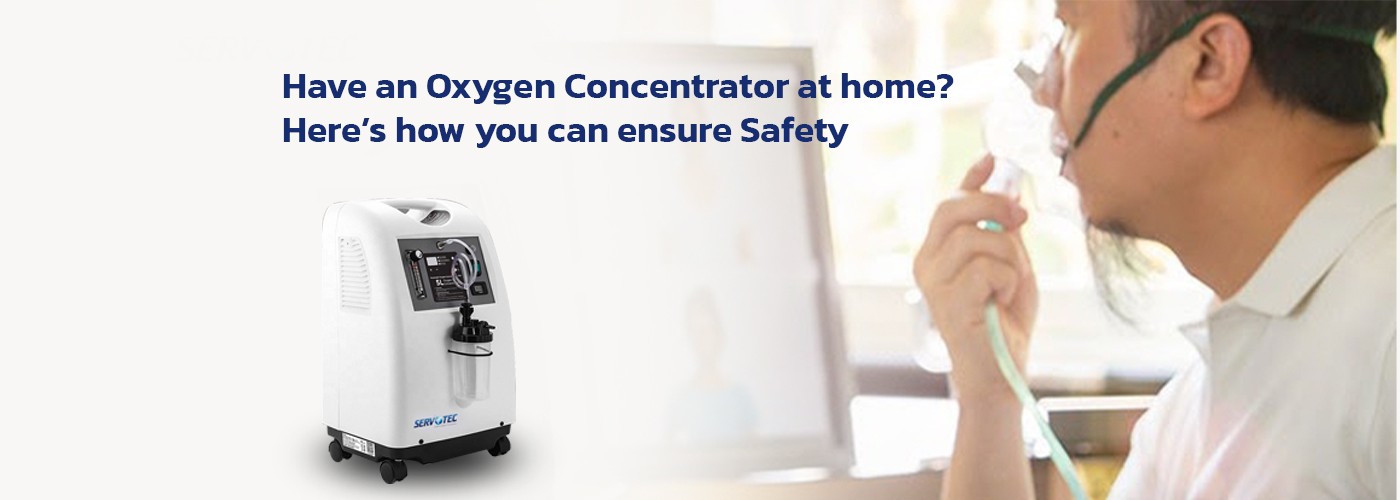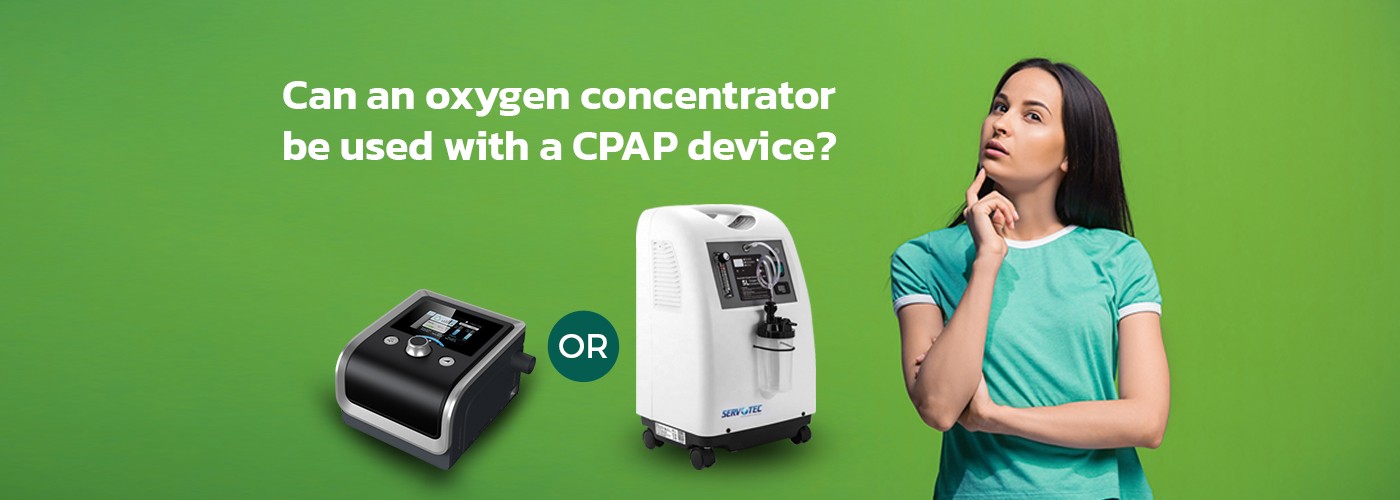Have an Oxygen Concentrator at home? Here’s how you can ensure Safety

Oxygen concentrator or COPD is characterized by a loss in lung function that worsens as the disease advances. As a result, most COPD patients will eventually need supplemental oxygen to support their lungs once they are unable to absorb enough oxygen on their own.
Supplemental oxygen is delivered to your lungs by a pressurized oxygen tank or an oxygen concentrator to provide particularly oxygen-rich air. Because this air is often 85-95 percent pure oxygen, your lungs can absorb more oxygen with each breath.
Supplemental oxygen is an important aspect of COPD treatment because it allows your lungs to take in enough oxygen to meet the needs of your organs and tissues. Without it, your blood oxygen saturation can drop to dangerously low levels, causing hypoxemia, which can lead to serious, life-threatening problems.
Supplemental oxygen is also useful for treating acute COPD symptoms, and it can help you if you get out of breath while exercising or if your symptoms worsen. Supplemental oxygen is also used by many patients to treat low blood oxygen levels during the night.
We’ll show you how to practice good oxygen safety in this post so you may avoid accidents, injuries, or fires caused by utilizing supplemental oxygen. We’ll go through the advantages and disadvantages of oxygen therapy, as well as how to avoid fire hazards and follow basic safety protocols when using, storing, and transporting your oxygen.
Hazards involved with Supplemental Oxygen
Standard oxygen tanks, the most popular type of supplemental oxygen equipment, come with their own set of risks. When oxygen is held in a tank, it must be kept at a high pressure, which implies that if the container is broken or ruptured, the oxygen can burst violently or “go off like a rocket.” An oxygen concentrator equipment can help you avoid this hazard, but they are more expensive and harder to come by. Because their budget, insurance, or medicare provider won’t pay it, many people don’t have access to anything other than pressurised or liquid oxygen tanks.
The Advantages of Supplemental Oxygen
Despite the hazards, supplemental oxygen is normally highly safe to use if used carefully and according to instructions. It’s also a critical component of treatment for patients with COPD and other respiratory illnesses who can’t receive enough oxygen on their own to keep healthy.
Supplemental oxygen therapy can considerably relieve COPD symptoms including dyspnea, coughing, wheezing, and exhaustion by increasing blood oxygen levels and relieving some of the load on your lungs. It can also make it simpler to walk, exercise, and keep your symptoms under control, allowing you to be more active and participate in more of life’s activities.
Here are some additional advantages of using supplementary oxygen therapy:
- Increased mental acuity and mood
- Increased energy and less weariness
- Better cardiovascular health
- Hypoxemia and the risk of hypoxia are reduced.
- Better sleep
- Breathing problems are less common.
- Lowering the risk of COPD complications such as pulmonary hypertension and heart failure.
The need for supplementary oxygen for COPD cannot be overstated. If your doctor has prescribed oxygen for you, it’s critical that you follow your treatment plan carefully.
Guidelines for Using Oxygen in a Safe and Effective Manner
We’ll show you how to practise good oxygen safety now that you have a greater understanding of the benefits and risks of oxygen therapy. Everyone who utilizes supplemental oxygen must take a number of crucial precautions in order to limit the risk of flames and burns.
We’ll provide you a number of methods for preventing oxygen leaks and reducing fire threats in your home in the following sections. We’ll go over all of the different flammable compounds and spark hazards to be aware of, as well as how to cook safely with oxygen at home.
Stopping Oxygen Leaks
Preventing oxygen from leaking out of your tank or mask is one of the most critical aspects of supplemental oxygen safety. A major fire threat exists if too much oxygen escapes into the air. That’s why, when using supplementary oxygen, it’s critical to understand how to manage your equipment securely.
Here are some pointers on how to avoid oxygen leaks:
- When turning the valve on your oxygen container, use caution. Slowly open the valve to avoid releasing too much-compressed oxygen at once.
- When you’re not using your oxygen tank, remember to close the valve. If you’re not sure it’s closed all the way, take the time to double-check.
- Visually inspect any oxygen tanks you have on a regular basis, particularly the valves. Examine the outside of the tank for signs of wear, tear, or damage, as well as any visible leaks.
- Keep your tanks in a safe, secure location where they won’t topple, fall, or be damaged.
- Because liquid oxygen tanks leak if they’re stored on their sides, it’s especially crucial to keep them upright in a car.
While using supplemental oxygen, no matter how careful you are to prevent leaks from your tank and tubing, a little quantity of oxygen will inevitably seep out around your nose and mouth.
That’s why staying away from heat, sparks, and anything else that could cause the oxygen to combust is so critical. In the following sections, we’ll go through this in further depth.
When using oxygen, follow these guidelines to avoid heat and flame hazards:
- Cooking with supplemental oxygen should be done with extreme caution. To use your supplementary oxygen, go at least five feet away from the burner, and never use your nasal cannula near a gas stove or open flame.
- At all times, keep your device at least five feet away from the stove and other heat sources.
- When using oxygen, stay away from all open flames, such as lighters, matches, candles, fireplaces, cigarettes, gas burners, and so on. While oxygen is being used, do not use any of these products or allow anyone near you to start a flame.
- When utilising oxygen, do not smoke, use an electronic cigarette, or vape. Heating elements in e-cigarettes have the ability to ignite the oxygen that gathers around your nasal cannula, resulting in serious facial burns.
- When you’re near where you store your oxygen and extra tanks, use the same precautions you would when using supplementary oxygen. Make sure you and everyone else in your house know where your oxygen tanks and equipment are stored and how to use them properly in the event of a fire.
Here are some suggestions for lowering your fire risk.
- When utilizing oxygen, avoid utilizing electronic gadgets. Electric razors, mechanical toys, heating pads, electric blankets, electric toothbrushes, and electronic hair dryers, curlers, and straighteners are among the items in this category.
- When using supplemental oxygen, avoid using any electronic item that generates heat. Electronic cigarettes are included in this category.
- Avoid textiles that produce static, such as wool, nylon, and synthetic materials (e.g. polyester). Instead, opt for cotton clothing and bedding, which is less likely to generate static electricity.
- Don’t use any flammable lotions, hair treatments, or hair sprays on your skin or hair that could catch fire due to heat or a static spark in the presence of oxygen. Keep an eye out for petroleum-based goods and opt for water-based alternatives instead.
- When using supplemental oxygen, avoid using chapstick and oil-based lotions on your body, especially your face, as these can cause severe burns if they ignite.
- When utilising supplementary oxygen, never utilize aerosol sprays. Air fresheners, spray deodorants, and hairsprays all fall under this category.
- When using supplemental oxygen, avoid using alcohol-based hand sanitizers. If you use hand sanitizer before using oxygen, ensure sure it is totally dry before turning on the machine or contacting any of your oxygen equipment.
- Using a humidifier during dry weather can help to lessen the amount of static electricity in your home. When using supplemental oxygen, keeping your residence at an optimal humidity level (typically about 40 percent humidity) might alleviate your COPD symptoms as well as lower your fire risk.
- If you use an oxygen concentrator, be sure it’s plugged into a grounded outlet (an outlet with three holes instead of two). Never use an extension cable, a broken outlet, or an outlet with other electronics plugged in.
Here are some pointers to help you make sure you’re using your oxygen in well-ventilated areas:
- Check to see if your home’s ventilation system is in good operating order.
- If you’re driving or moving an oxygen tank while taking supplemental oxygen, crack the windows in your automobile.
Here are some tips for making sure you use your oxygen in well-ventilated places:
- Make sure the ventilation system in your home is in good working order.
- Crack the windows in your car if you are using supplemental oxygen while driving or transporting an oxygen tank.
- You should never put anything on top of your oxygen tank. Any oxygen that seeps out could become trapped and build up to dangerously combustible levels if this is done.
- Store your oxygen tanks in a clean, open area where air can readily circulate around them. Never keep your oxygen tanks in a closed place or somewhere without adequate ventilation.
When handling your equipment, use caution.
Here are some pointers on how to handle and use your oxygen equipment safely:
- Make sure you don’t drop your oxygen tanks. When moving your tanks from one location to another, use a stand, trolley, or another secure container.
- Never pull or roll your tanks over the floor, never set them down too hard, and never let them collide with walls or other objects.
- Never raise or carry your oxygen tanks by the cap or valve; always lift or carry them by the bottom or sides of the tank.
- Your oxygen equipment, including tanks, tubing, and electrical wires, should never be covered. They should not be placed underneath any fabric, furniture, or bedding.
- If an oxygen tank has been dropped or is damaged, do not use it.
Final Thoughts
Anyone suffering from COPD should understand how to utilize oxygen safely. Most patients will require supplemental oxygen at some point during their lives, and knowing how to use it safely can help prevent fatal fires and injuries.
Even though most people who use supplementary oxygen have no concerns, a fire or a burn might be caused by a poorly timed mistake or a stroke of bad luck. When something goes wrong, the ramifications can be devastating, which is why being sloppy or negligent is never worth the risk.
Even while taking supplemental oxygen carries certain major dangers, you can greatly reduce them by following correct oxygen safety procedures and keeping your equipment clean and well-maintained. This oxygen safety guide can help you make supplementary oxygen as safe and risk-free as possible for you or someone you care about.




